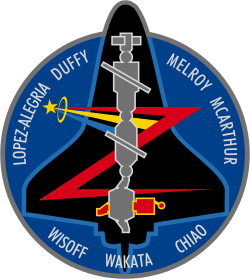Pamela Ann Melroy
| Pamela Ann Melroy | |
|---|---|
 | |
| Astronaut | |
| Statsborger | USA |
| Nationalitet | Amerikaner |
| Født | 17. september 1961 Palo Alto, Californien |
Andet arbejde | Instruktør og Testpilot |
| Uddannelses- sted | U.S. Air Force Test Pilot School Massachusetts Institute of Technology Bishop Kearney High School Wellesley College |
| Rang | Oberst, USAF |
| Udvælgelse | 1994 |
| Mission(er) | STS-92 STS-112 STS-120 |
| Missionsemblemer | |
Pamela Ann Melroy (født 17. september 1961) er NASA astronaut, har har fløjet én rumfærgemission som kaptajn og to som pilot.
Eksterne henvisninger
- Biografi af Pamela Melroy NASA (engelsk)
| Spire Denne biografi om en amerikaner er en spire som bør udbygges. Du er velkommen til at hjælpe Wikipedia ved at udvide den. |
Medier brugt på denne side
Designed by the crew members, the STS-92 patch symbolizes the second mission to carry U.S.-built elements to the International Space Station (ISS) for assembly. The black silhouette of the Space Shuttle Discovery stands out against the deep blue background of space in low Earth orbit. In the foreground in gray is a profile view of the ISS as it appears when the shuttle and crew arrive, with the station consisting of the Unity node, its two pressurized mating adapters (PMA), the Zarya functional cargo block, the Zvezda service module, and the Progress cargo vehicle.
Following the shuttle's rendezvous and docking, the ISS configuration will be augmented by the two elements delivered by Discovery–the Z1 truss and PMA-3. These two elements, depicted in red, will be installed using the shuttle's robot arm and be connected to ISS during four spacewalks. The multi-national nature of both the STS-92 crew and the ISS are reflected in the multi-colored Astronaut Office symbol.
The STS-112 emblem symbolizes the ninth assembly mission (9A) to the International Space Station (ISS), a flight which is designed to deliver the Starboard 1 (S1) truss segment. The 30,000 pound truss segment will be lifted to orbit in the payload bay of the Space Shuttle Atlantis and installed using the ISS robotic arm. Three space walks will then be carried out to complete connections between the truss and ISS. Future missions will extend the truss structure to a span of over 350 feet so that it can support the solar arrays and radiators which provide the electrical power and cooling for ISS. The STS-112 emblem depicts ISS from the viewpoint of a departing shuttle, with the installed S1 truss segment outlined in red. A gold trail represents a portion of the Shuttle rendezvous trajectory. Where the trajectory meets ISS, a nine-pointed star represents the combined on-orbit team of six shuttle and three ISS crew members who together will complete the S1 truss installation. The trajectory continues beyond the ISS, ending in a six-pointed star representing the Atlantis and the STS-112 crew.
The STS-120 patch reflects the role of the mission in the future of the space program. The shuttle payload bay carries Node 2, the doorway to the future international laboratory elements on the International Space Station. On the left the star represents the International Space Station; the red colored points represent the current location of the P6 solar array, furled and awaiting relocation when the crew arrives. During the mission, the crew will move P6 to its final home at the end of the port truss. The gold points represent the P6 solar array in its new location, unfurled and producing power for science and life support. On the right, the moon and Mars can be seen representing the future of NASA. The constellation Orion rises in the background, symbolizing NASA's new exploration vehicle. Through all, the shuttle rises up and away, leading the way to the future.





